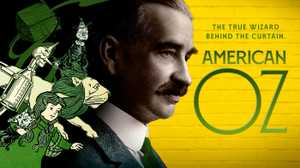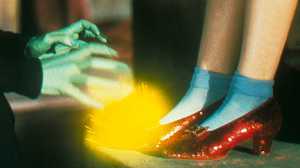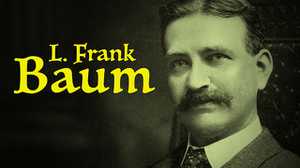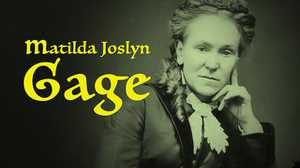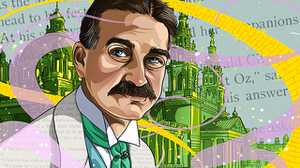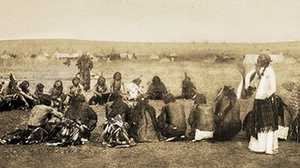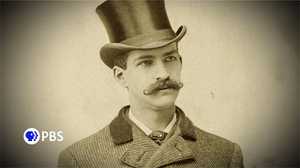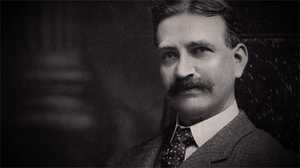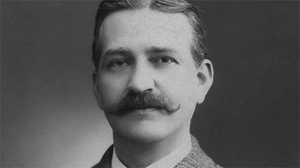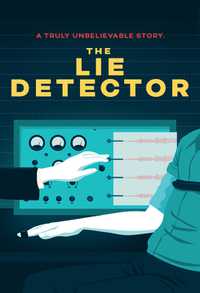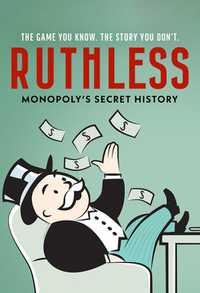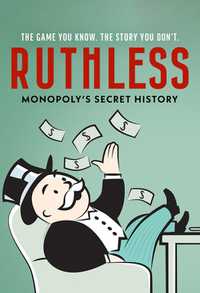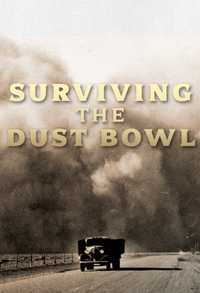NARRATION: On November 3, 1956, families all across America gathered in their living rooms for the first television broadcast of The Wizard of Oz. Forty-five million viewers tuned in. Its annual airing on television would cement the story in the American consciousness.
GREGORY MAGUIRE, WRITER: My parents were dubious about television. Once a year they lowered their inhibitions and restrictions, and that was when The Wizard of Oz was rebroadcast.
LOUIS WARREN, HISTORIAN: When I was a kid, I saw The Wizard of Oz for the first time on a color TV and was just stunned when you made that transition from the black-and-white photography to the color photography.
DINA MASSACHI, AMERICAN STUDIES SCHOLAR: I don't remember the first time I saw it. What I remember is wanting to be Dorothy.
MARIA E. MONTOYA, HISTORIAN: The two images that have stuck with me my whole life, the witch and the flying monkeys absolutely terrifying.
EVAN SCHWARTZ, WRITER: The movie is not only the most seen movie of all time, but it's the most repeatedly viewed movie of all time. Itís almost impossible to conceive of American life without growing up with The Wizard of Oz.
NARRATION: The Wonderful Wizard of Oz first appeared more than half a century earlier, as a childrenís book. Published in 1900, the story of Dorothyís fantastical journey down the yellow brick road was the brainchild of L. Frank Baum, a writer whose penchant for reinvention reflected a uniquely American brand of confidence, imagination and innovation. During a time of rapid change, he wrote a fairytale that embraced the values and direction of a new society.
LOUIS WARREN, HISTORIAN: Baum is at the center of a kind of culture of inviting people to dream of a new life.
PHILIP J. DELORIA, HISTORIAN: The Wizard of Oz is the quintessential story of going to another world, working out issues and problems, and then returning and being in a better place in a world that is challenging.
MARIA E. MONTOYA, HISTORIAN: What's underlying this seemingly easy children's story is actually a complicated person who has a complicated story, and brings all that to the underpinnings of the book.
DOUGLAS A. JONES, JR., HUMANITIES SCHOLAR: His life suggests a kind of American spirit on the cusp of a new century turning towards what the modern and the new would be.
NARRATION: On a chilly evening in January 1894, a determined Lyman Frank Baum wrote his mother from a small rail town west of Chicago, rejecting her offer of support. "I shall somehow manage to provide for those dependent on me," he told her. A tall order for the impractical man who throughout his adult life had quit work where he found successó and pursued his passions into near-ruin.
Narration: To support his family in the midst of a crushing economic depression, thirty-seven-year-old Baum, who went by Frank, had accepted a trial position as a traveling salesman. Working on commission, he hauled heavy trunks of breakable glassware and dishes to store owners across the Midwest.
MICHAEL PATRICK HEARN, WRITER: Even though heís barely getting by selling crockery on the road, heís determined to support his family on his own, on his own terms. He was always looking for the next best thing, where he might, might make some decent money.
SHARON HARTMAN STROM, HISTORIAN: Baum was trying to find a way that he could stay at home and be with his family, not be on the road. That was his ultimate goal.
EVAN SCHWARTZ, WRITER: He started to reconnect to his original childhood dream of being a great writer and started writing poems and stories on any scrap of paper he could find.
NARRATION: As he journeyed from town to town, Baum bore witness to a nation in transitionóa country of shifting tastes, increasing population and growing industrial might. He traveled across a land in which vast fortunes were being made; at the same time, millions lived in extreme poverty.
PHILIP J. DELORIA, HISTORIAN: Baum sits at the cusp of the changes of the 19th century as it gives way to the 20th century, and Americans are, are forced to think self-reflectively about what's happening to their country, thinking about what was, and what will be.
ROBERT BAUM, GREAT GRANDSON: He would be meeting new people, going to new places, hearing new things, seeing new things. All of these could be food for his imagination.
MICHAEL PATRICK HEARN, WRITER: L. Frank Baum was always aware of the importance of the imagination. He basically nurtured his imagination and he trusted it.
KENT DRUMMOND, COMMUNICATIONS SCHOLAR: The imagination could sometimes be fueled by, uh, the, the travails of the world. It enabled him to imagine places where want, and depression, were not a possibility.
NARRATION: Baum channeled his keen observations into magical tales. The most famous of which would become "America's First Great Fairy Tale" —a story about an almost unbelievable journey that projected the sentiments of its author, a man who wanted to find his place in the world and to make his way back to his family.
WONDERFUL WIZARD OF Oz V.O.: No matter how dreary and gray our homes are, we people of flesh and blood would rather live there than in any other country, be it ever so beautiful. There is no place like home.
EVAN SCHWARTZ, WRITER: Home was coming back to your hopes and dreams. It was more than just family. It was a sense of self as well.
THE WIZARD OF OZ (1939): GLINDA: "Tap your heels together three times. And think to yourself, there's no place like home, there's no place like home." Dorothy: "There's no place like home; there's no place like home."
ROBERT BAUM, GREAT GRANDSON: My great grandfather, L. Frank Baum, grew up on a place called Rose Lawn, which was his parentsí home and farm. Roselawn consisted of a gorgeous house with a big library, lots of books. There were fields and forests and streams. This was a wonderful place to be a child.
NARRATION: Born in 1856, Frank Baum enjoyed an idyllic childhood on the outskirts of Syracuse, New York. His father, originally a barrel-maker, had struck it rich in the oilfields of Pennsylvania, making him a wealthy man during a volatile era of industrialization.
DINA MASSACHI, AMERICAN STUDIES SCHOLAR: Baum grew up reading fairy tales that were older European fairy tales, your Brothers Grimm and Hans Christian Andersen. A lot of them end with very didactic morals, and they're dark.
MICHAEL PATRICK HEARN, WRITER: He loved the adventure of these stories and also the, the magic and, and the wonder that they possessed.
NARRATION: "Childhood," Baum would later write, "is the time for fables, for dreams, for joy."
SALLY ROESCH WAGNER, WOMENíS STUDIES SCHOLAR: His imagination was where he spent much of his time. He could explore his passions. And, the fanciful world that he created then I think stayed with him throughout his life.
NARRATION: At age 19, when he was old enough to start earning a living for himself, Frank Baum showed little interest in following in his father's footsteps. After a short stint as a store clerk, Frank struck out on his own path. He decided to ride the wave of an unusual national craze, breeding fancy chickens. To support this new passion, his father established B.W. Baum & Sons on the family 80-acre stock farm adjacent to Rose Lawn.
EVAN SCHWARTZ, WRITER: Frank wasnít content just to breed chickens for food. He wanted to breed fancy chickens that were gonna be shown at various festivals and, and shows. And it was really emblematic of the way he approached almost every endeavor. He wanted to be the best at it.
NARRATION: A leading trade magazine praised him as one of the most active and enthusiastic fanciers, and noted his prolific and pleasant writing for various poultry journals. But Baumís interest in the fancy poultry craze did not last long.
KENT DRUMMOND, COMMUNICATIONS SCHOLAR: Frank Baum was a restless spirit and he was always looking for the next big thing. There was always something more and so there was, there was a quest.
SHARON HARTMAN STROM, HISTORIAN: The obsessions of many Americans in the late 19th century were to get beyond the small world of the village; to change their identities and occupations; to imagine a whole new way of being as in comparison to their parents and grandparents.
MARIA E. MONTOYA, HISTORIAN: Baum is a middle-class man of white-American descent, and so he can freely move across the North American landscape. And so when something calls to him he has the resources to jump on that dream and try to make it work for him.
NARRATION: Twenty-four-year-old Frank Baum headed to New York City in 1881 to study acting.
MICHAEL PATRICK HEARN, WRITER: Frank Baum loved to perform. He was basically a ham. And this was one profession that he felt he could make a name for himself. But, it was not considered a particularly admirable profession to go into theater at that time.
SHARON HARTMAN STROM, HISTORIAN: There's a view in proper American society that acting is kind of a low-grade occupation. But the public loves actors. Itís a way to become popular.
NARRATION: Baum soon landed a job touring with a repertory company. He played small roles under the name George Brooks, and was described as a deserving actor "who had genuine dramatic ability," but Frank aspired to something more. He wanted to write, produce and star in his own plays, and asked his father to bankroll his new venture.
MICHAEL PATRICK HEARN, WRITER: His father was very indulgent to Frankís interests. If Frank wanted to sell poultry, he would support him on that. If he wanted to become an actor, he was the one who put up the money.
NARRATION: On May 15, 1882, crowds in Syracuse, Baumís hometown, flocked to the Grand Opera House to see the premiere of Frank's first theatrical creation, a musical melodrama titled The Maid of Arran. Written under the name Louis F. Baum, the play told a story of adventure and romance.
DOUGLAS A. JONES, JR., HUMANITIES SCHOLAR: Baum would be in a tradition of theater makers who were trying to make it respectable. They were trying to make a theater that was both popular, which is to say profitable, but also respectable so they could bring in middle class audience members, so they could bring in church members.
ROBERT BAUM, GREAT GRANDSON: This was Frank's big chance, this was his play. He did the scenery, he did the music, he did the lyrics to the song, and he actually sang on stage.
SHARON HARTMAN STROM, HISTORIAN: Theater is one of the early forms of make believe. As a theater maker he was continuing a lifetime of playing. Itís a way of expressing his inventiveness and disappearing into another world.
NARRATION: Among the attendees at the Grand Opera House that night was Maud Gage, an independent-minded 21-year-old student at Cornell University, one of the few male colleges that had begun admitting women. The couple had been courting for months.
SALLY ROESCH WAGNER, WOMEN'S STUDIES SCHOLAR: When Frank met Maud, he met a woman probably unlike any that heíd met before. She was smart, she was witty, she was opinionated. This is a woman to contend with.
ROBERT BAUM, GREAT GRANDSON: Frank saw, in Maud, all the things he didnít have. She saw in him a life that would be very different and wonderful, and must have seen his abilities and talents and wanting to be a part of it,
NARRATION: The young couple faced resistance from Maud's mother, Matilda Joslyn Gage. A formidable figure, Gage was a nationally-known activist in the growing movement for womenís equality. She was a founding member with Susan B. Anthony and Elizabeth Cady Stanton of the National Woman Suffrage Association. Matilda had very definite thoughts about her daughterís new suitor.
DINA MASSACHI, AMERICAN STUDIES SCHOLAR: At first she didnít like L. Frank Baum. Here is this actor that her college daughter is going to drop out of school to run off with and, no, no, that's not gonna work. But, Maud was just as stubborn as her mother and said, "No. I, I'm doing this."
NARRATION: On November 9, 1882, Frank and Maud married in the parlor of the Gage home in Fayetteville, New York. "The promises of the bride," a local paper noted with surprise, "were precisely the same as those required of the groom."
SALLY ROESCH WAGNER, WOMEN'S STUDIES SCHOLAR: This is at a time in the 1880s when men expected subordination and subservience from women. And it was a unique man who wanted to be with a woman who spoke her own mind, who would not be dominated. And I think it speaks volumes about the character of Frank that he loved a woman with that kind of strength. Matilda's biggest fear about Frank, he has, uh, all these fine qualities, but, Lord, he is never gonna be able to make a living.
NARRATION: After the wedding, Maud joined Frank and his company of actors on the road, going on a westward tour with The Maid of Arran. But winter in the plains wasn't kind to the production.
EVAN SCHWARTZ, WRITER: The tour of The Maid of Arran was very successful at first, but Frank really pushed it. He kept it going too long. And it ends up going into Kansas, and it was really telling that Maud wrote a letter saying, "I couldn't be paid to live here. This is the grimmest place iíve ever seen."
NARRATION: Frankís responsibilities changed dramatically that spring when he found out that Maud was pregnant. He now recognized a career in the theater was not going to pay the bills, and closed down the tour.
DINA MASSACHI, AMERICAN STUDIES SCHOLAR: You see Baum feeling the pressure to succeed. Being a man in that time, there was even more pressure because there was really the expectation he would provide for his family.
MICHAEL PATRICK HEARN, WRITER: I think it was devastating when The Maid of Arran failed. This was the first time he really had control of his own life and was doing something he really enjoyed. He was building a career that suddenly was gone. And then he wrote his father begging him, basically, for a job.
EVAN SCHWARTZ, WRITER: Frank Baum came of age when America was transforming from an agrarian, agricultural society into an urban, industrial society, and it was happening at breakneck speed with all kinds of new technologiesóthe railroad, the telegraph, the telephone, and it was unsettling for people. The Wonderful Wizard of Oz was created out of American parts.
Scene from Wizard of Oz (1939) - Dorothy: "Where do you want to be oiled, first?" Scarecrow: "He said his mouth."
EVAN SCHWARTZ, WRITER: Frank Baumís talent was turning these visual symbols into meaningful and sometimes spiritual symbols that worked in the context of the story. Tin Man: ìMy goodness, I can talk again!î
GREGORY MAGUIRE, WRITER: One of the things that Baum contributed to our understanding of how the imagination works in storytelling, but perhaps also in the industrializing world in which he was working, is that he taught us to take the scraps, and bits, and shards and to assemble them into something new.
NARRATION: In May 1883 after almost six months on tour, Frank and Maud returned to Syracuse where Baumís father set him up in the family oil business. Frank's job was marketing Baumís Castorine Oil, a new petroleum product used on horse-drawn carts and buggies. The young sales superintendent managed to conjure the drama in axle grease.
SUSAN ARONSTEIN, LITERARY SCHOLAR: Baum understood very instinctively that one of the ways in which people connected to products was through the idea of narrative. The Castorine Oil ad in which you see a dandy in his carriage looking utterly appalled that these scruffy children in a farm wagon and a pony have just raced past him. It tells the story about, you know, "Oh boy. I'm gonna be humiliated by a bunch of little kids if I don't have the right oil. He sold that oil in a way that would catch people's eye.
EVAN SCHWARTZ, WRITER: Frank Baum was a natural salesman. He was always trying to connect with people, to please people. He could make up stories about anything. Whether it was chickens or cans of oil, Frank Baum had a story for it.
NARRATION: Sales were good and Frank was able to support his growing family.
NARRATION: In February of 1886, shortly after the birth of his second son, Frankís older brother died suddenly. A year later, after Frank had taken on new responsibilities in the Castorine Oil companyóhis father died.
MICHAEL PATRICK HEARN, WRITER: When his father died that was an important lifeline that he lost.
EVAN SCHWARTZ, WRITER: He didnít want to continue the oil business. He wanted something greater, something more in tune to who he was.
NARRATION: In the summer of 1888, after visiting Maudís brother in Dakota Territory, Baum decided to move out West. "I realize how crowded the East is, and how competition keeps a man down," he wrote to his brother-in-law. "In your country, there is an opportunity to be somebody."
JEANINE BASINGER, FILM HISTORIAN: The prairie has two different effects on people. It opens them up to their own significance and importance. Itís a place in which they can make their mark, or it tends to crush them, even drive them mad. You either use your imagination and feel capable of handling it or you don't.
SALLY ROESCH WAGNER, WOMENíS STUDIES SCHOLAR: Cyclones were the terror. If they struck, they removed entire buildings. Wizard of Oz (1939) scene with storm. Aunt Em (shouts): "Dorothy!"
MICHAEL PATRICK HEARN, WRITER: Baum had a great sense of transformation. Baum turns the cyclone into something positive.
Wonderful Wizard of Oz V.O.: In the middle of a cyclone the air is generally still, but the great pressure of the wind on every side of the house raised it up higher and higher, until it was at the very top of the cyclone; and there it remained and was carried miles and miles away as easily as you could carry a feather.
MICHAEL PATRICK HEARN, WRITER: It should have been something so destructive, devastating, and yet that becomes Dorothy's way of going to the Land of Oz.
NARRATION: Three months after his visit to Dakota Territory, Frank, Maud and their two young sons boarded a train heading west, bound for Aberdeen, a city just then shimmering to life. Aberdeen had already grown from fewer than 300 people at its founding six years earlier, to more than three thousand. And showed no signs of slowing.
MICHAEL PATRICK HEARN, WRITER: These were not people who came out in, in covered wagons. They came out on the railroad and they were young, adventurous capitalists thinking that they were going to make it big. They didnít know what to expect, they were basically, uh, betting on hope.
NARRATION: Built at the crossroads of three railroads, the "Hub City," as it was known to its proud new residents, was a boom town. Aberdeen boasted schools, a library, an opera house, a telephone company, banks, hotels and restaurants. The latest modern convenience, electric lights, lined the townís dusty streets. Eastern transplants like Frank Baum were convinced their fair city would be the next Chicago, or Minneapolis, or Kansas City.
LOUIS WARREN, HISTORIAN: The West is so much the subject of a hard sell by land agents for the railroad corporations and by other boosters in the region who will paint all kinds of pictures of what a glorious verdant paradise South Dakota will be.
EVAN SCHWARTZ, WRITER: Aberdeen at that time was trying to position itself as part of Americaís breadbasket. They were building out a town that was surrounded by farmland.
LOUIS WARREN, HISTORIAN: The railroads would advertise the land promising that this is a place where middle-class families will proliferate, and all of the comforts of a good middle-class home will be yours.
MARIA E. MONTOYA, HISTORIAN: When people like Baum and other settlers head out into the American West in the 1880s, they think theyíre coming into an empty landscape. And nothing could have been farther from the truth. What theyíre actually walking into is a landscape thatís been inhabited for hundreds, and in some cases, thousands of years.
LOUIS WARREN, HISTORIAN: The land that Aberdeen was on and most of The Dakotas had been part of the homeland of the Western Sioux or Lakota. For Baum, as for most western settlers, Indian people were often an afterthought if they thought about them at all.
NARRATION: Not long after Baum and his family had settled in Aberdeen, a group of Native Americans arrived in town. "Crowds of curious white men," a local paper reported, stared at the delegation of Lakota leaders who had stepped off the train for dinner. Sitting Bull, famed Lakota chief and decisive victor over the U.S. Calvary at the Battle of Little Bighorn, drew the most attention.
PHILIP J. DELORIA, HISTORIAN: Imagine that experience if you're Sitting Bull or if you're part of this delegation, you're put on display for this town that sit and gawk at you. White Americans have always seen Native people in contradictory terms. "They are noble, children of nature." "No. They're degraded savages." And Baum shows up at, at exactly a moment when these contradictions are getting really complex, and changing towards a more harsh and hostile racialization.
MARIA E. MONTOYA, HISTORIAN: Native Americans are being consolidated, they're being moved and put onto reservations.
LOUIS WARREN, HISTORIAN: For most Americans, the idea that native people had to give up land so that white people could take it, that was just the way of the world. As far as Lakotas were concerned it was theft.
NARRATION: On Monday, October 1, 1888, less than two weeks after moving to town, Frank Baum—dramatically announcing his arrival—held a much-publicized grand opening of a new store called Baumís Bazaar. Nearly a thousand people showed up, some likely enticed by the promise of "a box of chocolates, shipped in from Chicago, for every lady attending."
SUSAN ARONSTEIN, LITERARY SCHOLAR: He had a flair for the theatrical. And so for him the store is a stage. It had to be an experience, It's like, "Come, see the exotic goods. See it all on display. Youíve never seen so much in one place before."
NARRATION: "On either side of the room," raved a local newspaper, "are cases of pottery, glassware, toys, oxidized brass ornaments, Japanese novelties, fancy leather and plush goods."
PHILIP J. DELORIA, HISTORIAN: He doesn't go to start a feed store. He goes to start a novelty store. He sells all kinds of things, many of which are not actually needed, but they represent the dreams and the desires of people to engage in this new kind of world of goods and commodities.
MICHAEL PATRICK HEARN, WRITER: Baum wrote all the ads that appeared in local newspapers for Baumís Bazaar. He would have special events to bring people into, into the store. Baum believed in entertaining children and all the kids just loved going to Baumís Bazaar because there were all these wonderful toys.
NARRATION: "Mr. Baum has demonstrated in a very short time," wrote the Aberdeen Daily News, "that he possesses to an enviable degree the push and enterprise necessary to the western businessman."
NARRATION: n May 1889, Baum and a group of local businessmen put up the money for the "Hub City Nine," Aberdeen's first professional baseball team. The town built a field and a grandstand that could seat five hundred. Baumís Bazaar supplied the teamís jerseys, bats and gloves.
KENT DRUMMOND, COMMUNICATIONS SCHOLAR: Baum envisions himself as being really the harbinger of civilization for Aberdeen, this potentially great city on the Great Plains. So heís imbued with this sense of transformation that starts through the consumption of exotic goods but leads to so many other things.
Narration: Baum planned to start new clubs, lawn tennis, stamp collecting, photography, bicycling and stock all the necessary supplies on the shelves of Baum's Bazaar.
EVAN SCHWARTZ, WRITER: He got really involved in the civic life of the town and tried to create a sense of community around the store. It wasnít just about selling, but about bringing people together.
MICHAEL PATRICK HEARN, WRITER: I think that Baum was hoping that Baumís Bazaar would draw people from outside of Aberdeenópeople from the farms, from the other towns would come to this new mecca of South Dakota.
JEANINE BASINGER, FILM HISTORIAN: The Dakota Territory is a harsh environment. The winters are very, very cold, and hard, and long. The summers are hot, and dry, and challenging.
SALLY ROESCH WAGNER, WOMENíS STUDIES SCHOLAR: Youíre out on the prairie, your nearest neighbor is a mile away, you don't see anything on the horizon but flatness.
KENT DRUMMOND, COMMUNICATIONS SCHOLAR: Baum envisioned people could go into this store; it would be a tremendous escape. And it would be one in which they could completely forget about the workaday world. Itís very magical and itís transformative.
LOUIS WARREN, HISTORIAN: What Baum is saying is, "It's okay to dream about having those nice things. Why shouldn't you have them? There's nothing wrong with it. Go ahead. Buy them. Express yourself through your purchases."
NARRATION: Frank's big ideas, persistent optimism and lack of experience of the vagaries of farming blinded him to the realities of life on the Plains. After years of consistent rain, a drought hit the region in 1889. Wheat fields turned into dust, and heavy winds blew away freshly sown seed. By harvest time, crop yields had plummeted.
LOUIS WARREN, HISTORIAN: It is one of the worst droughts in American history. Many of the farmers fall on very hard times, and in that moment Baum's Bazaar is not gonna do well.
SALLY ROESCH WAGNER, WOMENíS STUDIES SCHOLAR: When farmers donít have money for seed wheat they are not gonna buy toys for their children. And while there was a short boom when Baumís Bazaar may have made sense, by 1890 there was no way it could succeed at all.
NARRATION: Baumís Bazaar closed on January 1, 1890 after only fifteen months in business. Maud had just given birth to their third child. "Frank had let his tastes run riot," his sister-in-law later said. "It was too impractical a store for a frontier town."
EVAN SCHWARTZ, WRITER: The economic situation for the Baum family was dire. He was really on a shoestring now, very little money, but he used whatever money he had left to take over a newspaper. And he tried to make a go of it, falling back on his talent for writing.
SHARON HARTMAN STROM, HISTORIAN: Baum was very optimistic about his own talents. Whatever situation he's in he figures out a new strategy for selling something or selling himself.
NARRATION: Just a month after he shuttered Baumís Bazaar, Frank published the inaugural edition of The Aberdeen Saturday Pioneer.
LOUIS WARREN, HISTORIAN: Getting into that business is both a way that he can express his interest in writing, but itís also a way for him to paint pictures with words of the future of Aberdeen and the future of South Dakota.
NARRATION: Baum was at pains to set his weekly apart from the townís eight other papers, and put his faith in his own distinctive voice. Under the heading "The Editor's Musings," Baum offered his personal opinions on a wide range of topics.
LOUIS WARREN, HISTORIAN: Baumís voice as a newspaper editor was an interesting voice. He writes about alternative religions. He writes about spiritual mediums in his newspaper. These are not topics that every editor would touch.
NARRATION: The issue Baum most strongly championed in 1890 was Woman suffrage. South Dakota had become a state the previous year, and an amendment to give women the vote would be decided in the November election. Frank's support of the suffrage movement stemmed from time he spent with his mother-in-law, Matilda Joslyn Gage, who was a frequent visitor to Aberdeen.
DINA MASSACHI, AMERICAN STUDIES SCHOLAR: Gage was very involved with the Baum family, and she really influenced L. Frank Baum. He joined the Suffrage Movement because of her. And you see this play out in his newspaper writing.
EVAN SCHWARTZ, WRITER: Frank Baum wrote editorial after editorial trying to convince fellow towns folks to vote for womenís rights.
NARRATION: "We must do away with sex prejudice and render equal distinction and reward to brains and ability," Baum argued, "no matter whether found in man or woman."
SALLY ROESCH WAGNER, WOMENíS STUDIES SCHOLAR: His respect for women I think is strengthened seeing these western women. They had already succeeded in proving themselves as equals to the men. If youíre homesteading you are an active participant in the process.
MARIA E. MONTOYA, HISTORIAN: White women who are moving out into the American West are seen as bringing civilization to these communities. This is not possible, without the labor of women, both the physical labor of women but the cultural, social, political labor of women to build these communities.
MICHAEL PATRICK HEARN, WRITER: Frank was determined to get the vote in South Dakota. He believed in progress. He believed we were always advancing forward. And, he generally assumed that other people would just agree with him.
NARRATION: "This great question, involving the political future of our wives, mothers, sisters and daughters will be decided for South Dakota next Tuesday," Baum appealed to his readers. "The enfranchisement of one-half of the citizens of this great state is in your hands."
NARRATION: On Election Day, November 1890, nearly 70,000 men across South Dakota went to the polls. Womenís equality was soundly rejected, by a margin of two to one. "What a reproach upon our civilization," he wrote, "and upon the people of a state who have made a pretense of being liberal and just!"
NARRATION: The drought that began in 1889 dragged on for nearly two years, exposing the lie of railroad promoters and land agents that the rain follows the plow.
MICHAEL PATRICK HEARN, WRITER: The great American Dream turned out to be a nightmare for these people. And Frank Baum was out there witnessing this. And all of this is expressed in the opening chapter of The Wonderful Wizard of Oz.
The Wonderful Wizard of Oz V.O.: "When Dorothy stood in the doorway and looked around, she could see nothing but the great gray prairie on every side. The sun had baked the plowed land into a gray mass, with little cracks running through it. Even the grass was not green, for the sun had burned the tops of the long blades until they were the same gray color to be seen everywhere."
LOUIS WARREN, HISTORIAN: One of the most telling moments in The Wizard of Oz is right at the beginning with the description of Aunt Em and Uncle Henry as old before their time, as unable to imagine happiness.
The Wonderful Wizard of Oz V.O.: "Uncle Henry never laughed. He worked hard from morning till night and did not know what joy was. He looked stern and solemn, and rarely spoke."
LOUIS WARREN, HISTORIAN: Baum in many ways is saying that this Western dream seems to have hit a wall. Itís a place of great disappointment for many of the people who had invested their lives in it.
NARRATION: On the Standing Rock and Pine Ridge reservations west of Aberdeen, conditions were even more dire for the over 10,000 Lakota living there. And with access to only meager government rations, many families were on the verge of starvation.
NARRATION: In the middle of this unfolding apocalypse, a new religion known as the Ghost Dance began to spread through many western tribes. They believed the dance, which preached a defiant message of hope, would wash away the white settlers and return the land to its original state.
PHILIP J. DELORIA, HISTORIAN: It's a regenerative religious practice. Itís not people yelling and screaming. You do this dance until you sort of fall into a vision state, and you fall down out of the circle, and you have a vision, and people come and take care of you, and other people keep dancing. White Americans see this and they think that the Ghost Dance is the prelude to an armed uprising.
NARRATION: Desperate to keep his Aberdeen dream afloat, Frank blasted rival newspapers for ginning up a "false and senseless scare," fearing that headlines screaming of "Indian uprisings" would drive settlers away. "After two years of successive crop failures," he wrote, "comes the Indian scare, and the consequence is we are getting a very bad name."
EVAN SCHWARTZ, WRITER: A lot of businesses were going under and the economic collapse in South Dakota was threatening his very concept of home. He invested so much of himself there that it was almost unthinkable that everything would collapse.
NARRATION: President Benjamin Harrison ordered his Secretary of War to suppress the Ghost Dance, by force if necessary. On December 15, 1890, Lakota Chief Sitting Bull was shot and killed on the Standing Rock Reservation during a botched arrest for his alleged support of the Ghost Dance. When news reached Aberdeen, one hundred and fifty miles away, the townspeople feared retaliation.
LOUIS WARREN, HISTORIAN: It creates a response of panic among white people. Newspaper editors begin to demand federal protection in case thereís what they call an outbreak.
NARRATION: Baum's newspaper ran wire reports warning of imminent reprisal. Caught up in the mass hysteria and watching his Aberdeen efforts spiraling into failure, Frankís usually optimistic rhetoric changed drastically. In an editorial, he praised Sitting Bull, but described the remaining Lakota people as a ìpack of whining cursî and called for a vicious ethnic cleansing.ìThe Whites, by law of conquest, by justice of civilization, are masters of the American continent,î Baum asserted, ìand the best safety of the frontier settlements will be secured by the total annihilation of the few remaining Indians.î
SHARON HARTMAN STROM, HISTORIAN: Baum thinks that the extermination of Native Americans is inevitable. His view of tolerance comes out of the milieu that he is in. Itís really about middle-class white people getting along well.
NARRATION: The US Army dispatched troops to disarm and arrest a group of Lakota, including followers of Sitting Bull. Within days of these orders, the US Seventh Cavalry massacred as many as 300 Lakota men, women and children at Wounded Knee Creek.Frank responded again. ìHaving wronged them for centuries, we had better, in order to protect our civilization, follow it up by one more wrong and wipe these untamed and untamable creatures from the face of the earth.î
PHILIP J. DELORIA, HISTORIAN: What Baum says in the editorials tells us exactly how Americans are seeing Indian people. Thereís no mercy, no quarter, no sympathy. It is a definitive and defining statement of intense racial animosity. And I think Baum is capturing, perhaps, some of his own ambivalence, but he is channeling a major, and important, and deadly current of American thought.
SALLY ROESCH WAGNER, WOMENíS STUDIES SCHOLAR: I donít know how to understand Frankís reaction other than to understand that an "either-or" interpretation of history is a lie, that we're "both-and." L. Frank Baum carried that, that poison of racism in him that I carry, that we all carry as settlers.
NARRATION: The drought, the despair, and the foreclosures continued. Ad sales dropped and subscriptions dried up, forcing Baum to abandon his newspaper and make plans to leave Aberdeen. His western venture had turned into another failure.
THE WIZARD OF OZ (1939) - DOROTHY: "But how do I start for Emerald City?" Glinda: "It's always best to start at the beginningóand all you do is follow the Yellow Brick Road."
GREGORY MAGUIRE, WRITER: Dorothy goes into a land in which magic spells are part of the apparatus of governance.
THE WIZARD OF OZ (1939) - DOROTHY: "Follow the yellow brick road?
GREGORY MAGUIRE, WRITER: And most of what she achieves she achieves without recourse to the magic. She comes with her true grit. She just puts one foot in front of another along the Yellow Brick Road to achieve what it is that she needs to do.
DINA MASSACHI, AMERICAN STUDIES SCHOLAR: There is a real American value of being self-reliant, and you see that with Dorothy. Dorothy really set the stage for little girls getting out of the house and going on adventures the way that boys do.
MARIA E. MONTOYA, HISTORIAN: She goes on what is quintessentially the great American quest to find the place that will bring her happiness, will bring her the things that she needs.
NARRATION: Frank Baum next set his sights on a new homeóChicago, Illinois.
EVAN SCHWARTZ, WRITER: Chicago was the most dynamic and energetic city in America. It had been devastated in the fires of 1871 but it had completely rebuilt itself. There was a sense of hope and optimism for the future of America.
LOUIS WARREN, HISTORIAN: In many ways Chicago was the city of 19th century America.
PHILIP J. DELORIA, HISTORIAN: This massive, large, industrial city, which is at the center of really making continental America at this time. It is the center of the flow of commodities. It is a center for immigration. African Americans from the South, immigrants from Europe, people who give up on their homesteading and make their way into the larger city.
NARRATION: Arriving with little money, Maud set up their growing household, which now included a fourth son, in a small rental house in a working-class neighborhood. She taught embroidery lessons to help the family stay afloat. Frank briefly worked at a daily paper before landing a higher-paying sales position at a wholesale crockery firm.
NARRATION: The most exciting project in Chicago when the Baums arrived was the construction of the highly anticipated Worldís Columbian Exposition, known as the Chicago Worldís Fair. Conceived as a celebration of the 400th anniversary of Columbusí voyage to America, the exposition was an immediate sensation when it opened on May 1, 1893. Over the next six months, 27 million fairgoers from around the world descended on Chicago to witness the spectacleóFrank Baum and his family among them.
PHILIP J. DELORIA, HISTORIAN: The Chicago Worldís Fair is a place where America is sort of proclaiming its own. It has arrived. It is a showcase for modern industrialism, for technological innovation.
DOUGLAS A. JONES, JR., HUMANITIES SCHOLAR: It was an attempt in the white American imagination of understanding the United States as being the leading light in this new century. It was a way in which to show the world in 1893 that America was at the vanguard of a new, modern, western world.
NARRATION:In the Electricity Building, visitors marveled at the 80-foot tower of light created by the Wizard of Menlo Park, Thomas Edison. He had patented a mind-boggling number of inventions and proved to be a master of self-promotion.
JEANINE BASINGER, FILM HISTORIAN: Thomas Edison is this great combination of imagination, and forward-looking modern ideas, and also a businessman who makes money from the things that he does. So this would undoubtedly be inspirational to Baum who himself was looking to find that thing that he could do that would make him not so much famous but successful, rich, or at least occupied in a way that he enjoyed.
EVAN SCHWARTZ, WRITER: There was a sense of magic and wonder and splendor that really appealed to Frank Baum, that almost anything was possible if you could imagine it.
NARRATION: The centerpiece of the Exposition was a gleaming man-made lake, surrounded by neoclassical buildings of monumental proportion, each with a bright, white exterior. The White City, as it was called, was constructed as a temporary affairóall paint and plaster. But breathtaking.
LOUIS WARREN, HISTORIAN: The White City looks like a vision of some imaginary place that is supposed to call Americans to think about what their cities could be. It is a giant space for dreaming about the American future, and Baum wouldíve found that enormously attractive.
MICHAEL PATRICK HEARN, WRITER: They created this ideal city, and in some respects itís very much the same metaphor that we see in The Wizard of Oz. The Wizard of Oz (1939) Guard: ìWho rang that bell?î Dorothy, Scarecrow, Tin Man and Lion:ìWe did.îThe Wonderful Wizard of Oz V.O: The streets were lined with beautiful houses all built of green marble and studded everywhere with sparkling emeralds. Even the sky above the City had a green tint, and the rays of the sun were green.
MICHAEL PATRICK HEARN, WRITER: The Emerald City is not really as green as we think it is. It turns out that everyone has to wear green glasses so they think the Emerald City is far greener than it really is.
PHILIP J. DELORIA, HISTORIAN: One of the things that happens in the Emerald City is the realization that all of this may just be a charade. The world that seems so alluring, and so true, and so desirous may all just be a fraud. And, the White City gives us that as well.
NARRATION: The Exhibition Halls of the White City were reserved for high art, high culture, and advanced science. But the real energy of the Fair was on the outskirtsóa mile-long, open-air boulevard known as the Midway Plaisance. Thousands of fairgoers paid to see Egyptian belly dancers, dwarf elephants, Hindu jugglers, snake charmers and a young entertainer named Harry Houdini. Towering above the crowds was the first-ever ferris wheel. At over 250-feet, a ride to the top provided a birds-eye view of the city and beyond. A New York entrepreneur ordered a ferris wheel for his park in Coney Island, telling a reporter, "We Americans want either to be thrilled or amused, and are ready to pay well for either sensation."
KENT DRUMMOND, COMMUNICATIONS SCHOLAR: At this moment in American history entertainment was becoming commoditized. There were vaudeville shows. There were Wild West shows. There were amusement parks.
MARIA E. MONTOYA, HISTORIAN: What weíre now seeing is entertainment for the masses. Anybody can participate in it. People are beginning to work for wages in the cities. They have money at the end of the day that they will spend not only on the things that they need to feed themselves and clothe themselves, but now they have money to spend on entertainment.
KENT DRUMMOND, COMMUNICATIONS SCHOLAR: There were all sorts of theatrical experiences that had to do with experiencing someone elseís imagined world that they beckoned you to enter into.
NARRATION: The clangorous urban life of Chicago, and its Worldís Fair, fed Baumís penchant for noveltyóin all things. For some time, Frank had been drawn to an emerging philosophical and religious movement called Theosophy. "Its followers," he described, "are simply 'searchers after Truth." ...[They]...are the dissatisfied of the world, the dissenters from all creeds."
LOUIS WARREN, HISTORIAN: Thereís a dissatisfaction with conventional Protestantism and Catholicism. There are people searching for new ways of relating to their creator and to the cosmos, and Theosophy was for many people a very attractive alternative.
EVAN SCHWARTZ, WRITER: Theosophy was appealing because it combined Hinduism, and
Buddhism, and Western science. It was a way of introducing Eastern religions to America for the first time.
EVAN SCHWARTZ, WRITER: Frank Baum learned about this new amalgam of spirituality from his mother-in-law, Matilda Gage, who really embraced it as a way of calming her own mind.
SALLY ROESCH WAGNER, WOMEN'S STUDIES SCHOLAR: The parts of theosophy I think that most resonated with Matilda Joslyn Gage were the idea that that which is scientifically provable is not necessarily the only reality, that that which is considered supernatural, the occult, thatís just simply a reality that hasnít been tested and measured yet.
EVAN SCHWARTZ, WRITER: Theosophists believed in projecting your body and your mind into another realm of consciousness that they call the astral plane. Some of the concepts that later showed up in, in The Wonderful Wizard of Oz might have been inspired from Theosophy, especially this idea of traveling to a new plane of imagination.
NARRATION: Escape from the daily reality was at a premium by the turn of 1894. The American economy had tumbled into the most punishing depression in its history. A quarter of all working people lost their jobs, and their paychecks, with no government safety net to soften the fall. Just months after the exposition closed, two fires swept through the fairgrounds leaving much of the recently radiant White City in ruins.
NARRATION: Baum tried to remain optimistic as he scraped out a living for his family as a traveling salesman.He was beginning to get tired of the extensive traveling. The more he aged, the more he realized he needed to find something that he could, that would really support him.
NARRATION: While on the road, Baum found time to start writing again, and began submitting short stories and poems to writing contests and local newspapers.
EVAN SCHWARTZ, WRITER: He kept a record of failure, literally logging the rejections he was receiving from magazines and publishers and the occasional success. You could see Baum persevering.
NARRATION: Sometimes Frank spun fantastical tales to entertain his boys when he got home from a long week on the road.
MICHAEL PATRICK HEARN, WRITER: L. Frank Baum loved being a dad. He was so indulgent of his own children. When he was home with them he would spend as much time as he could with them and he would create these elaborate little stories. And one night Matilda happened to overhear them.
SALLY ROESCH WAGNER, WOMENíS STUDIES SCHOLAR: Matilda is a well-published author at this point. She knows the publishing world and she knows what could sell. She tells Frank to write the stories and publish them. She is challenging him, there is a powerful, intellectual relationship between them.
NARRATION: Gage had recently published what she described as her ìchief life work.î Titled Woman, Church and State, she called for a more just and equal society, one that returned to earlier civilizations where women wielded the same power as men.More radical, however, was her indictment of religion for its role in womenís oppression across the world. She explored the history of witchcraft and argued that women were accused of being witches because the Church found their intellect threatening.
SALLY ROESCH WAGNER, WOMENíS STUDIES SCHOLAR: Women were burned as witches to remove the knowledge of women, the power of women, the authority of women, and to really place women in a subordinate position. One of the things she talks about is that women defined as witches were wise women. They had voice. They had power.
EVAN SCHWARTZ, WRITER: Matilda as a role model to Frank was essential. And I think he really took to heart some of the ways that people viewed his mother-in-law. People called her satanic and a heretic, yet he saw that she was very kind. He developed this dual notion of witches, that there could be a good witch and a bad witch.The Wizard of Oz (1939): Glinda descends in a big pink ball. Ö Glinda: "Are you a good witch or a bad witch?"; Dorothy: "I'm not a witch at all. Witches are old and ugly."
GREGORY MAGUIRE, WRITER: The phrase ìgood witchî doesnít really come into the culture until L. Frank Baum. Witches from European and English fairy tales were old, and gnarled. How brave and thoughtful it was of Baum to take those two words that seemed to have magnetic pulls in opposite directions, the word ìgoodî and the word ìwitchî and to hinge them together so that they could mean something new.The Wizard of Oz (1939): Wicked Witch of the West: "You stay out of this, Glinda! Or I'll fix you as well."
MICHAEL PATRICK HEARN, WRITER: One of the important aspects of Oz is the real power is with the witches, both the good and the bad. Theyíre the ones who have the power.The Wizard of Oz (1939): Wicked Witch: ìiíll get you, my pretty! And your little dog, too.î The Wicked Witch of the West cackles and disappears into a ball of flames.
GREGORY MAGUIRE, WRITER: Before the end of the 19th century books provided for children were almost entirely for instruction, their aim was to educate. What happened in the United States is that there began to be a population of middle class children. They were children who did not have to work in the mines, or the mills. There was enough prosperity that kids could be a little bit more childlike for slightly longer. And that allowed for a growth of an industry to help entertain them. Now we have time to go to the gym of the mind, as it were, to make ourselves strong in our capacity to imagine new things.
SUSAN ARONSTEIN, LITERARY SCHOLAR: This is a period where there is a sense of children as a
special class that have a vivid world of imagination and play available to them; that gets lost with adulthood and that that time should be valued.
NARRATION: In late 1897, forty-one year old Baum published Mother Goose in Prose, inspired by the stories he had been inventing for his boys. ìNow that I am getting old,î Frank wrote his sister, ìmy first book is to amuse children.î
MICHAEL PATRICK HEARN, WRITER: He wanted to make children feel good. He wanted them to know the joy of reading and the joy of, of wonderful stories.
DINA MASSACHI, AMERICAN STUDIES SCHOLAR: Baum was the eternal boy. He never really grew up. If you leave behind your childhood and really are firmly grounded in the adult world itís hard to think of that rich, fertile, imaginative way that children think and play, and I donít think Baum ever left that.
NARRATION: Mother Goose in Prose was a critical success, but did not bring the fame or the financial reward Baum desired. "I have been more worried than usual over business matters this summer," Frank confessed in a letter to his sister, ìand have scarcely spent time to sleep and eat. ...I have wanted to find some employment that would enable me to stay at home."
SHARON HARTMAN STROM, HISTORIAN: He's a willful person, but heís also a strategist in his own life, of finding a way out of a situation he doesnít like and then using his talents to create a new one.
KENT DRUMMOND, COMMUNICATIONS SCHOLAR: If you were walking down State Street in Chicago, you would be offered a cavalcade of sights, and sounds, and sensations. One of the most important of which would be the shop windows, and the most effective store windows would be like the soul of the store. And if you could look in those windows and be captured, and be enticed, then maybe it would be enough to go in.
LOUIS WARREN, HISTORIAN: The American economy turns more and more to a dynamic that relies on selling goods to consumers, and merchants have to invent new ways of getting people to want things, which is one of the big transitions thatís happening in the late 19th and early 20th centuries. And Baum is at the center of that transition.
NARRATION: "I conceived of the idea of a magazine devoted to window trimming," Baum explained to his sister, ìwhich I know is greatly needed.îThe first issue of The Show Window, a trade journal that instructed merchants in the art of window display, appeared in November 1897.
SUSAN ARONSTEIN, LITERARY SCHOLAR: Baum is very aware of the tricks of advertising. Heís very good at using them. He had a talent for and interest in technology, a talent for and interest in sales. He knew how to present and frame things and he knew how to tell a story. And The Show Window called on all of those things.
NARRATION: An executive at Marshall Fieldísóthe gold standard of retail in downtown Chicagoóhailed The Show Window as ìan indispensable organî for department stores. Circulation took off, gaining thousands of subscribers in a few months, and Baum was finally able to quit his traveling salesman job and spend more time at home. For the first time in his life, Frank Baum was making a solid living.
NARRATION: Not long after the start of his new venture, Matilda Gage died of a stroke while visiting the Baums in Chicagoóleaving Maud inconsolable and Frank without one of his most stalwart supporters.
NARRATION: For a writer and magazine editor like Baum, Chicago was an ideal city. It had become a major center for commercial printingósecond only to New York.
DINA MASSACHI, AMERICAN STUDIES SCHOLAR: Chicago at that time was really booming with writers, artists and publishers. Baum was a very charismatic likable kind of guy who seemed to make friends very quickly and easily, and one of the connections he made was William Wallace Denslow.
MICHAEL PATRICK HEARN, WRITER: Denslow was one of the most important illustrators in Chicago at the time. And Baum met him at the Press Club of Chicago and the two of them started talking about possibly doing a book together.
NARRATION: Frank was already at work on a series of comic rhymes that was a twist on Mother Goose, and Denslow agreed to do the illustrations. Their first collaboration, Father Goose, His Book, became an unexpected best-seller.
NARRATION: Energized by his success, Baum threw himself into his next big writing project.
SALLY ROESCH WAGNER, WOMENíS STUDIES SCHOLAR: The intuitive process of writing is that you absorb everything around you and that becomes fuel for the process of writing. And you draw from places that you donít even know youíre drawing from.
NARRATION: Baum set out to tell the story of Dorothy, a young orphan girl stranded in the vast and unforgiving American landscape. Dorothyís dreary life on a Kansas farm is changed in a flash when a fierce cyclone drops her in a strange and wonderful land called "Oz." The story at the heart of the book was Dorothyís quest to get back home to her aunt and uncle in Kansas. The Good Witch of the North points the way, which leads down a yellow brick road, where Dorothy is to enlist the help of the Great Wizard of Oz. ìIt is a long journey,î the good witch warns, ìthrough a country that is sometimes pleasant and sometimes dark and terrible.î
JEANINE BASINGER, FILM HISTORIAN: It's a story of a journey and being given a challenge by a new world where you have to learn what it is, face its dangers, find new friends, and get yourself together in it.
NARRATION: Dorothy accumulates a trio of traveling companions along the wayóa Scarecrow, who wishes he had brains, a Tin Woodman, who longs for a heart, and a Cowardly Lion, who seeks courage.
KENT DRUMMOND, COMMUNICATIONS SCHOLAR: They want her to fulfill her dreams as well as have their own dreams come true, and so they set off on this journey together that gives them that sense of camaraderie and community.
DINA MASSACHI, AMERICAN STUDIES SCHOLAR: He did not see gender the way a lot of people of his time saw gender. His supporting Scarecrow, Tin Man, Lion didnít conform to this typical male role. You have the Tin Woodman, who is so sensitive that he cries when he steps on a beetle.
MICHAEL PATRICK HEARN, WRITER: There are very few girls who are as assertive as Dorothy is in The Wonderful Wizard of Oz. In every other fairy tale the heroine has to marry the prince. But Dorothy doesnít have to wait for her prince to come; she goes out and solves her own problems.
SALLY ROESCH WAGNER, WOMENíS STUDIES SCHOLAR: The voice of Dorothy, the sureness of
her, the confidence, the figuring out how to solve problems, thatís Maud, thatís Matilda.
Narration: On October 9, 1899, Baum declared his new manuscript complete. He dedicated the book to his wife Maud, who he called his ìgood friend and comrade.î Underneath was Denslowís spritely illustration of the Good Witch of the North.
NARRATION: The new book began to roll off the printing press in the first summer of a new century. It is "the best thing I have ever written, they tell me," a nervous Frank Baum wrote to his brother. "But the queer, unreliable Public has not yet spoken."
MICHAEL PATRICK HEARN, WRITER: When the book came out in 1900, it was not typical of the childrenís books being published at that time. The title was so intriguing, with this strange lion on the cover. No one knew what it was. And a book with full color, full page illustrations but also all these other two-color illustrations that changed as the story progressed from one episode to another. There was nothing on the market quite like it.
DINA MASSACHI, AMERICAN STUDIES SCHOLAR: Baum says in his introduction that he wants to create a modernized fairy tale full of wonderment where the heartache and nightmares are left out.
JEANINE BASINGER, FILM HISTORIAN: It's not like the fairy tales that come to us from Europe. Itís a more optimistic, less grim and dangerous world. Itís a world of solving problems.
GREGORY MAGUIRE, WRITER: What he did in The Wonderful Wizard of Oz was harness his great idea of a child going out and coming back home in strict, plain, American prose. He let the characters move about the landscape and speak with a sincerity with which America was then known and for which it was often much mocked. But it was a genuine tone. That what you say means something.
NARRATION: Reviews praised Baum for writing a story that ìnever insults childhood intelligence by writing down to itî and for his ability to make "the little girl's odd companions—seem very real." "Delightful humor and rare philosophy are found on every page."
DOUGLAS A. JONES, JR., HUMANITIES SCHOLAR: The Wonderful Wizard of Oz speaks specifically to a kind of American understanding of the modern periodótechnology, expansion, self-invention of the individual. At the center of that is adventure and dreaming.
EVAN SCHWARTZ, WRITER: It was about finding your place in the world, about identity and, ìWhere do I fit in?î Frank Baum was really pioneering a new literature for American children.
DINA MASSACHI, AMERICAN STUDIES SCHOLAR: The Wonderful Wizard of Oz was an instant best-seller. Everybody wanted to get their hands on it. It was wildly popular.
NARRATION: Overwhelmed by orders, the publisher went back to press four times. In the first Christmas season of the 20th century, it became the best-selling childrenís book in America.
NARRATION: On New Yearís Eve at one of Chicagoís finest restaurants, the Baums, with Denslow and his wife, toasted their great success. At age forty-four, Frank Baum had achieved the renown he had dreamed of all his life. An unflagging belief in his own imagination had finally paid off. ìSo everything conspires to make me glad,î he wrote his sister-in-law, ìand I send you heartiest wishes for a "glad New Year—and century."
NARRATION: On June 16, 1902, a staged musical adaptation of Baumís popular book, now with the shortened title The Wizard of Oz, opened to a packed house in Chicago. Frank Baum took enthusiastic curtain calls for this new interpretation of his cherished story. The idea of returning to the theater and the challenge of adapting his book for the stage had thrilled Baum, but it had been a rocky journey.
MICHAEL PATRICK HEARN, WRITER: When the director read Baumís libretto, he wrote across it, ìNo good.î He then brought in several script doctors and completely refocused the play.
NARRATION: By opening night, few of Baumís original lines remained in the script. ìThe original story was practically ignored,î Baum complained, ìthe dialogue rehashed, the situations transposed, my Nebraska wizard made into an Irishman.î
MICHAEL PATRICK HEARN, WRITER: There were all kinds of changes. Toto became a cow named Imogene. The producer added all kinds of secondary characters that had nothing to do with the original childrenís book. And Dorothy became a teenager who falls in and out of love throughout the play.
NARRATION: In the musical, Dorothy and Imogene were blown to Oz along with a waitress from Topeka named Trixie Tryfle, the Cowardly Lion was turned into a bit part and the Wicked Witch of the West was removed from the story.
DOUGLAS A. JONES, JR., HUMANITIES SCHOLAR: If you go back and read reviews, what they oftentimes latch on to are not the original parts, necessarily, from The Wizard of Oz, but how they were able to integrate elements from vaudeville, from minstrelsy, from the variety show, and from the circus into this musical.
DOUGLAS A. JONES, JR., HUMANITIES SCHOLAR: The musical was incredibly popular, particularly in the characters of the Scarecrow and the Tin Man. They kind of have a show within the show. What audiences saw in the dance routines was a set of movements, jokes and gags that were very popular on the minstrel stage. They took the new material of the musical and they melded it with popular elements of American theater culture and made them anew. So itís a transitional event in American popular culture.
NARRATION: The show was a smash hit in Chicago, then at New Yorkís Majestic Theatre, and then on a seven-year nationwide tour. Given the commercial success, L. Frank Baum was philosophical about the changes. If anyone understood the power of spectacle, it was the creator of Oz. ìThe people will have what pleases them,î Baum concluded ìand not what the author happens to favor.î
JEANINE BASINGER, FILM HISTORIAN: Here he is at the turn of the century, confronting what was really gonna be the main issue in terms of art and commerce. If youíre going to make a mass audience piece then youíre going to have to have it please a mass audience, and he makes a decision, ìI want my work to succeed in pleasing a large number of people so they will enjoy it and will return to seeing it.î
KENT DRUMMOND, COMMUNICATIONS SCHOLAR: What the success of the show told Baum about Oz as a commodity is that it had endless potential, and that here it was in a wholly new experience, a new medium, and it worked. It meant that so many more people could see it. I think he was smitten and he wanted more of it.
NARRATION: To capitalize on the musicalís success, Baum quickly wrote a new Oz book, The Marvelous Land of Oz. Published in 1904, it was marketed as a sequel that featured ìcharacters already famous the country over,î and added new Oz inhabitants, including Princess Ozma, the rightful ruler of Oz.
DINA MASSACHI, AMERICAN STUDIES SCHOLAR: Oz is this society run by women, and Oz itself really is this utopian version of America. In Oz, thereís plenty of everything. Everybody is provided for; everybody has what they need.
NARRATION: Two months after the bookís release, Baum started publishing a weekly newspaper serial, Queer Visitors from the Marvelous Land of Oz.
JEANINE BASINGER, FILM HISTORIAN: One of the things that is so significant about what Baum is doing here is he is creating a brand thatís built on his name and his particular product, which is Oz.
DOUGLAS A. JONES, JR., HUMANITIES SCHOLAR: Baum's work provides a window onto that which is popular and dominant in the American imagination in this period.
PHILIP J. DELORIA, HISTORIAN: Racial stereotypes have been central to American popular culture; those cultural forms are exploring how to reach larger mass audiences.
NARRATION: Like other creations of popular entertainment, Baumís Oz universeóas well as other writingsóreflected the countryís charged discourse around race and the related issues of national identity, immigration and colonialism.
DOUGLAS A. JONES, JR., HUMANITIES SCHOLAR: One of the lessons that I think Baum wants to teach in this new century is: How do we deal with difference? How do we deal with difference in the United States as a multiracial society? Baumís Oz books are about characters consistently encountering different types of persons, different types of animals, different types of objects and learning something about them.
NARRATION: Even as Baum modeled worlds where people with different features and backgrounds cheerfully interacted, he incorporated characters representing widely circulated racial stereotypes.
MARIA E. MONTOYA, HISTORIAN: The way that Baum characterizes others or different people in his writings, those were things that were just so embedded in American culture. Baum is just reflecting what American society thinks about these groups of people.
PHILIP J. DELORIA, HISTORIAN: It's always important to think about historical figures in complicated kinds of ways. The most interesting way to think about a life is to grab the stuff out of the corners and move it to the center and ask yourself, like, ìHow does this make me understand the person differently?
Narration: The musical had made Frank a wealthy man, and he and Maud reveled in the luxuries they could now afford, including a five-month tour of Europe and Egypt. Maud had a keen interest in Egypt as much of the teachings of Theosophy centered on accessing the secret wisdom of ancient knowledge. They explored the Temple of Isis and Frank joyfully watched as an undaunted Maud climbed to the top of the Great Pyramid. "Few women," Maud proudly stated, "undertake the feat."
NARRATION: At an oasis, the Baums met a family crossing the desert on a camel train.
ROBERT BAUM, GREAT GRANDSON: And on the back of the camel was a young girl and in this girlís arm on one side was her doll and on the other side, a first edition of "The Wonderful Wizard of Oz." This really surprised Frank, and he realized the widespread popularity of his book and how much the children loved the story.
NARRATION: The Baums summered at Macatawa Park, a resort town on Lake Michigan, where Frank wrote many of his books, and tried to answer the dozens of letters that arrived for him each day. This outpouring of affection inspired Baum to keep expanding the world of Oz. In each new sequel, he included an "Author's Note" about his young friends. "If...the little folks find this story "real Ozzy," Baum wrote in one, "I shall be very glad indeed."
SUSAN ARONSTEIN, LITERARY SCHOLAR: He's very much aware of the children as his audience and heís very much aware of building a relationship with them. Um, and he sees them as co-creators of Oz. Over and over again, he says, "I have responded to your request for more Oz." Oz becomes a conversation between Baum and his readers.
MICHAEL PATRICK HEARN, WRITER: Baum was always looking for new ways of promoting his books, and what was popular at the time were these travelogues. People would go around the country talking about China, or their trip to Japan and it would be a combination of hand colored slides and possibly some film. So Baum thought, "Well, why donít we do a travelogue of ...Oz?"
NARRATION: In 1908, Baum created a multimedia traveling show called The Fairylogue and Radio-Plays to coincide with the publication of a new Oz book. Baum narrated the story in person as the action unfolded onstage: a mixture of hand-colored lantern slides of illustrations from his Oz books and a series of short, hand-colored trick movies that he called ìRadio-Plays.î All accompanied by an orchestra performing an original score.
KENT DRUMMOND, COMMUNICATIONS SCHOLAR: It was this extraordinary vision of artistry, of technology, of inventiveness, and ultimately of risk taking. Now, if you read accounts of people who attended the shows they were absolutely transported. There were gasps. They were
completely caught up in it.
JEANINE BASINGER, FILM HISTORIAN: He understood that selling things was about embracing the media. It was about advertising that didnít look like advertising. And that, I think, is something very forward looking about him. He meshed the story and the creative artistic product with the sell, and thatís the real magic of what he was able to do so effectively.
Wizard of Oz (1939) - Cowardly Lion: "Look at that, look at that!" Wizard: "I am Oz. The great
and powerful."
MICHAEL PATRICK HEARN, WRITER: One thing L. Frank Baum deals with is appearance. Are things as we first encounter them? The Wizard of Oz turns out to be a humbug. The male leader of the country turns out to be not what he claims to be.
Wizard of Oz (1939) - Wizard (pulls curtain closed): "Pay no attention to that man behind the curtain!" Dorothy: "Who are you?" Wizard: I am the great and powerful Wizard of Oz." Dorothy: "You are!"
MICHAEL PATRICK HEARN, WRITER: The Wizard of Oz turns out to be no more than a flim-flam man, a circus performer from Nebraska.
Wonderful Wizard of Oz V.O.: "Really, 'said the Scarecrow, "you ought to be ashamed of yourself for being such a humbug. "O' I think you are a very bad man," said Dorothy. "Oh, no, my dear; I'm really a very good man; but I'm a very bad Wizard."
DOUGLAS A. JONES, JR., HUMANITIES SCHOLAR: Baum does not cast the Wizard as a villain figure, but rather he sees the Wizard as playing a very particular kind of function for this group of people who want something. He suggests that if deception can fulfill oneís desires, there is a need for that.
SUSAN ARONSTEIN, LITERARY SCHOLAR: If you think about what the Cowardly Lion, the Scarecrow and the Tin Man all want. What the Wizard gives them isnít that thing, but because they believe itís that thing, that actually does magically transform them.
NARRATION: n the early 20th century, Los Angeles was becoming the new capital of American popular culture and entertainment. Production companies had left New York to take advantage of the sunny climate and easy access to a variety of natural settings. Film studios began popping up all over Hollywood, a sparsely settled village surrounded by citrus groves.
NARRATION: In 1910, Frank and Maud, who had spent several winters in southern California and grown to love it, moved full-time to Hollywood. Baum built a comfortable home that he called Ozcot, and continued writing. He penned numerous books and series, often using both male and female pseudonyms. And he kept up with the demand for more Oz, making good on the arrangement with his publisher of producing one book a year. Calling himself "The Royal Historian of Oz," Frank divided his time between writing and nurturing his new flower garden.
NARRATION: He also joined the Uplifters, a social club of wealthy businessmen, artists and actors, many of them in the film industry. Baum enjoyed songs and lively conversation with what he called his "band of 'good fellows."
JEANINE BASINGER, FILM HISTORIAN: He found a group of creative, imaginative people and they decided that making, uh, the Oz books into movies would be a very good idea. Everybody loved the books. They were extremely popular. They felt that this would be a successful venture for them.
NARRATION: In 1914, the group put up $100,000 to launch The Oz Film Manufacturing Company with Baum as president. "I will put all my books into film, [so] that every child in the whole country may see them," Baum told a reporter.
NARRATION: At age 58, Baum threw himself into this new venture, building a massive seven-acre studio. Within two months, he had started filming their first production, The Patchwork Girl of Oz. Expectations and enthusiasm were high. Would-be chorus girls mobbed the studio looking to make their big break. A huge spread in a trade magazine hyped the anticipated release of the film. Baum, sparing no expense, opened The Patchwork Girl of Oz in the biggest movie theater in New York.
MICHAEL PATRICK HEARN, WRITER: Not only did they have very elaborate production values but also he had an original score for each of the films. But the audience said, "This is a kid's show. Why should adults be paying full price?" And the films were not well received. It was a big disappointment to him.
NARRATION: Baum produced four feature films, but the company fizzled out after only a year.
MICHAEL PATRICK HEARN, WRITER: After the failure of the Oz Film Company Baum pretty much retired to Ozcot and just continued writing an Oz book a year. He wrote other work as well but he was resolved to the idea that he should stick to what he knew best, and that was writing childrenís books.
KENT DRUMMOND, COMMUNICATIONS SCHOLAR: I think in Ozcot, Baum found his own personal Oz. It was the perfect bookend to what Rose Lawn had been when he was a child. It was a place to dream. It was a place to escape. And in some ways it was a return to childhood.
NARRATION: Ozcot also provided a tranquil place of convalescence as Frank had been suffering from congestive heart failure for some time. Gallbladder surgery weakened him even more. On May 6, 1919, just before his sixty-third birthday, L. Frank Baum died. The thirteenth Oz book was on its way to press, and Baum had left one more completed Oz manuscript.
KENT DRUMMOND, COMMUNICATIONS SCHOLAR: Here was someone who endured so many setbacks professionally. But, he was a visionary. He saw the future. He saw what things could look like.
NARRATION: Nearly twenty years after L. Frank Baumís death, on the studio lot of Metro-Goldwyn-Mayer, cameras started rolling on a new interpretation of The Wonderful Wizard of Oz.
MICHAEL PATRICK HEARN, WRITER: MGM was considered the top studio in Hollywood and every year they would put out what they called a prestige film. And this was a film that would really show off what the studio was able to do better than anyone else out there. The Wizard of Oz was going to be the prestige film for MGM in 1939.
NARRATION: There had yet to be a successful film version of The Wizard of Oz, and MGM was gambling an unprecedented $3 million on a Technicolor extravaganza to bring the beloved story to screen, starring Judy Garland as Dorothy.
SUSAN ARONSTEIN, LITERARY SCHOLAR: They knew it was a risk and they poured money into the promotion. MGM was very careful to position the film and the people involved in the film as readers and fans of Baum. The idea that, "There's continuity between us and the Baum books."
NARRATION: Over 5,000 fans cheered the parade of stars arriving for the filmís Hollywood premiere. Joining the crush of celebrities at the lavish event was 78-year old Maud Baum. ìOne of the greatest thrills of my life,î she proclaimed, ìwill be to see the land of Oz Ö come to life under the magic of MGM.î
NARRATION: The Wizard of Oz opened in theaters across the country on August 25, 1939.
Narration: The story born from L. Frank Baumís imagination and the hardships of the 19th century frontier would find its most enduring place in American culture at the tail end of the Great Depression.
WIZRD OF OZ (1939)—DOROTHY (SINGS): "Somewhere over the rainbow."
GREGORU MAGUIRE: As we were just coming out of the Depression and as war was on the horizon, The Wizard of Oz was an escapist moment. It was a chance for Americans, who had been working very, very hard for a very long time to keep body and soul together, to take a deep breath and get out of themselves.
NARRATION: "There is no cure for a troubled heart, or a troubled world," noted one review, "like a swift journey back to a cherished childhood memory. Metro-Goldwyn-Mayer's "Wizard of Oz" is just that: a memory glorified on the screen."
JEANINE BASINGER, FILM HISTORIAN: The 1939 MGM movie made Oz a world everybody could see and experience the same way so that it became real to people and defined collectively as Oz.
NARRATION: In 1959, CBS began annual broadcasts of The Wizard of Oz. The shared national event became a cherished tradition, firmly establishing the story as an American icon.
GREGORY MAGUIRE, WRITER: In the 1950ís, there was an uncomfortable sense of American certainty. We knew who we were, and that we were on top of the world. There is a lot of oppression in that and there is also a lot of possibility. When The Wizard of Oz was rebroadcast, what it did was provide those children who felt emboldened by that certainty to seek newness, to seek otherness.
NARRATION: In the years to come, The Wizard of Oz would be transformed again and again.
NARRATION: In January 1975, a new interpretation of The Wonderful Wizard of Oz opened on Broadway. Starring an all-black cast with Stephanie Mills as Dorothy, The Wiz was a modern retelling of L. Frank Baumís fairy tale. The show, subtitled "The Super Soul Musical," gave the story a new cultural framework.
AUDIO: The Wiz (1975) - Dorothy and cast sing "Ease On Down The Road"
DOUGLAS A. JONES, JR., HUMANITIES SCHOLAR: It is black theater makers grasping on to something thatís dear to Americans and saying, ìThis is ours too.î Itís about bringing the peculiar talents of these artists together to make claims on the American story, what some might call the most American of American stories.
SUSAN ARONSTEIN, LITERARY SCHOLAR: There hadnít been any real kind of vibrant Oz moments for quite a while. The Wiz updates it. It makes it modern, and new, and fresh.
NARRATION: The Wiz was a huge hit, winning seven Tony Awards, including best musical.
NARRATION: Three years later, Hollywood reworked the story as an urban fantasy set in Harlem. The movie featured megastars Diana Ross as Dorothy, a 24-year-old school teacher, and Michael Jackson as the Scarecrow. In both the stage and film versions, The Wiz explored African American struggle and resistance, and celebrated Black liberation.The Wiz (1978) Scarecrow sings ìYou Canít Win.î Dancers move to ìBrand New Dayî song.
DOUGLAS A. JONES, JR., HUMANITIES SCHOLAR: The Wiz is injecting themes, and images, and ideas of Black liberation, and celebration, and what people call Black joy precisely because these moments of celebration in the film allow for and show the ways in which African Americans can, and do, and continue to overcome.The Wiz (1978) Dorothy: ìIím ready now.î Addaperle: ìThink of home.î
JEANINE BASINGER, FILM HISTORIAN: This is a story that can be adapted to a different time and
place without really losing the fundamental idea of Oz and what it means to people.
PHILIP J. DELORIA, HISTORIAN: Who wouldíve thought that a failed entrepreneur would write a little story, which would have repercussions and reverberations across the whole course of the 20th century and into the future.
NARRATION: In 2003, one hundred years after Baumís first theatrical extravaganza, Oz returned to the stage as Wicked, a hugely-popular Broadway musical adapted from a novel. This 21st century take on Oz reimagined Baumís story from the point of view of the Wicked Witch of the West.
SUSAN ARONSTEIN, LITERARY SCHOLAR: Wicked focuses on the question of marginalization about, what is it like to grow up in a skin that people reject. What does it mean to have power as a woman? The focus on female friendship, all of those things I think revitalized Oz for a very new audience
Michael Patrick Hearn, Writer: Every generation reinterprets the story based upon what their experiences are. There is this power in Baumís imagination, Baumís invention.
DOUGLAS A. JONES, JR., HUMANITIES SCHOLAR: He was able to create and mold a set of characters that are with us across class, across race.
Gregory Maguire, Writer: We carried the meaning of the story wherever we went, which is that the small and the powerless can still have agency.
EVAN SCHWARTZ, WRITER: Baum left an indelible imprint on the American imagination. In a way, America has become a society of imagination and storytelling, and myth making.
NARRATION: Imagination,î Baum wrote, ìtransforms the commonplace into the great and creates
the new out of the old.
